TOGAF adalah sebuah kerangka organisasi terbuka. Kerangka itu sendiri adalah kumpulan pengetahuan yang terdokumentasi dengan baik, termasuk metodologi yang terperinci dan seperangkat alat pendukung untuk mengembangkan arsitektur perusahaan. TOGAF 9.2 adalah versi terbaru dari kerangka tersebut.
- TOGAF dikembangkan dan dipelihara oleh anggota The Open Group, yang bekerja dalam tim yang disebut Forum Arsitektur. Pengembangan awal TOGAF versi 1 dilakukan pada tahun 1995, dan versi-versi berikutnya dari TOGAF telah memperluas dan meningkatkan kumpulan pengetahuan ini.
- TOGAF dikembangkan melalui upaya gabungan lebih dari 300 anggota Forum Arsitektur yang mewakili beberapa perusahaan dan organisasi terkemuka di dunia – sehingga ini adalah ringkasan yang sangat baik tentang praktik arsitektur perusahaan secara umum.
- Mengembangkan dan memelihara arsitektur perusahaan adalah proses yang kompleks yang melibatkan banyak pemangku kepentingan dan proses pengambilan keputusan. TOGAF membantu dengan mendokumentasikan spesifikasi arsitektur perusahaan, proses, dan produk kerja.
- Dengan menggunakan TOGAF, organisasi dapat mengembangkan arsitektur perusahaan yang konsisten yang mencerminkan kebutuhan pemangku kepentingan, mengadopsi praktik terbaik, dan mempertimbangkan kebutuhan saat ini serta kebutuhan bisnis yang diperkirakan di masa depan.
Apa itu ADM?
Metodologi Pengembangan Arsitektur – sering disebut sebagai akronim untuk ADM – adalah proses langkah demi langkah yang terperinci untuk mengembangkan atau mengubah arsitektur perusahaan.
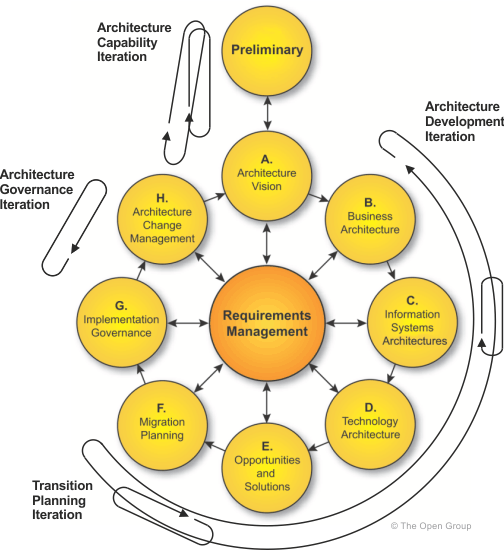
ADM menggambarkan 10 fase yang mencakup siklus pengembangan arsitektur.
Langkah-langkah ini adalah:
- tahap awal
- Fase A: Visi Arsitektur
- Fase B: Arsitektur Bisnis
- Fase C: Arsitektur Sistem Informasi
- Fase D: Arsitektur Teknis
- Fase E: Peluang dan Solusi
- Fase F: Perencanaan Migrasi
- Fase G: Menerapkan Tata Kelola
- Fase H: Manajemen Perubahan Arsitektur
- Manajemen Kebutuhan Arsitektur ADM

Tahap awal:
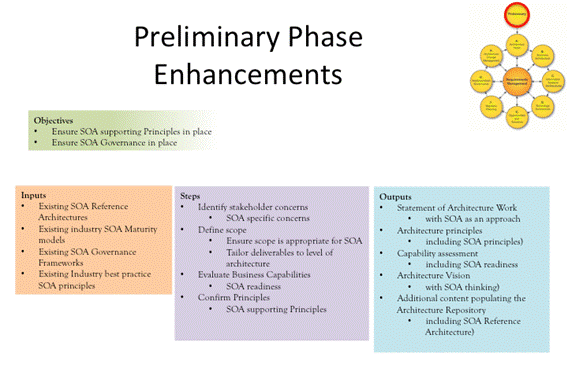
Tujuan utama dari fase awal adalah untuk mengidentifikasi dan menetapkan kemampuan arsitektur yang dibutuhkan oleh organisasi.
Bagian kunci dari ini adalah mengidentifikasi apa yang perlu dilakukan dan bagaimana cara melaksanakannya.Sebagai contoh, keluaran utama adalah permintaan kerja arsitektur yang menguraikan persyaratan dan memutuskan ruang lingkup, struktur, alat, atau kerangka arsitektur apa yang diperlukan untuk mendukung pekerjaan ini.
Pada tahap ini, TOGAF disesuaikan untuk memenuhi kebutuhan iterasi ADM yang akan datang. Kami mendefinisikan prinsip-prinsip dasar, menilai kemampuan arsitektur perusahaan dan bisnis untuk melakukan perubahan yang diperlukan, dan mengintegrasikan TOGAF dengan kerangka manajemen lainnya. Ada langkah-langkah dalam fase ini untuk membatasi organisasi perusahaan yang terpengaruh oleh perubahan yang diusulkan, mengidentifikasi kerangka tata kelola dan dukungan yang tepat, mendefinisikan dan membentuk tim dan organisasi EA, mengidentifikasi dan menetapkan prinsip-prinsip arsitektur, menyesuaikan TOGAF dan kerangka lainnya, serta menerapkan alat. Di akhir fase ini, tim EA harus siap untuk mengikuti iterasi siklus ADM. Ini sebagian karena tahap awal ditunjukkan di bagian atas diagram ADM dan di luar loop utama dari tahap A hingga H.
Fase A: Visi Arsitektur:
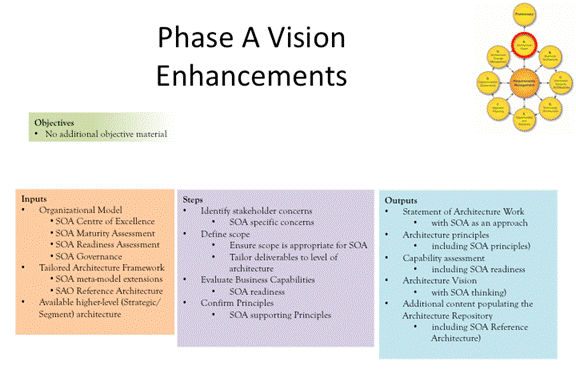
Fase A memberikan pernyataan kerja arsitektur yang jelas yang akan disediakan dalam iterasi ADM. Ini juga memberikan visi tentang arsitektur perusahaan yang diusulkan. Rasa arah ini sangat penting dalam membimbing pekerjaan ADM sepanjang iterasi. Ini pernyataan kerja arsitektur mendefinisikan prosedur kerja untuk mengembangkan dan menerapkan arsitektur yang diuraikan dalam visi arsitektur. Ini adalah visi yang memberikan keinginan tingkat tinggi untuk kemampuan dan nilai bisnis yang akan diberikan oleh arsitektur perusahaan yang diusulkan. Dimulai dengan aplikasi pekerjaan konstruksi, Fase A menyediakan alat (visi ini) untuk menjual manfaat dari kemampuan yang diusulkan kepada pemangku kepentingan dan pengambil keputusan dalam bisnis. Skenario bisnis digunakan untuk memahami persyaratan bisnis dan membantu memperjelas persyaratan arsitektur yang diimplikasikan oleh fungsionalitas yang diperlukan. Ini didokumentasikan dalam Pernyataan Kerja Arsitektur, yang digunakan untuk membangun konsensus untuk mendukung arsitektur akhir. Konsensus terjadi ketika organisasi sponsor menandatangani dokumen tersebut.
Langkah-langkah dalam Fase A semuanya tentang mengubah permintaan kerja konstruksi menjadi pernyataan kerja arsitektur yang jelas dan memastikan bahwa bisnis mampu, siap, bersedia, dan berkomitmen untuk melakukan perubahan arsitektur yang diperlukan. Ini melibatkan penetapan proyek arsitektur, termasuk mendefinisikan ruang lingkupnya, serta mengidentifikasi dan merinci prinsip-prinsip arsitektur dan bisnis. Fase A mengidentifikasi pemangku kepentingan dan kekhawatiran serta persyaratan mereka, dan mengidentifikasi tujuan bisnis, pendorong, dan batasan dalam fase awal. Untuk memastikan keberhasilan, ini juga menilai kemampuan bisnis, menilai kesiapan transformasi bisnis, dan menangani risiko transformasi yang ada.
Fase B: Arsitektur Bisnis:
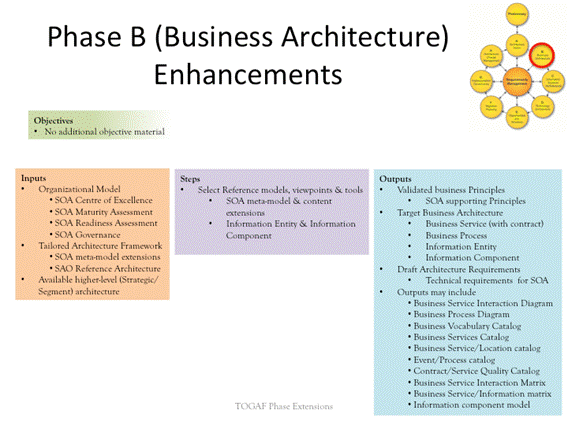
TOGAF mengadopsi arsitektur perusahaan sebagai cara untuk meningkatkan kemampuan bisnis – inilah sebabnya mengapa fase pengembangan arsitektur pertama berhubungan dengan arsitektur bisnis .
ADM dimulai dari perspektif bisnis – persyaratan bisnis yang kuat diidentifikasi dalam Permintaan Kerja Arsitektur di Fase Awal dan lebih lanjut disempurnakan menjadi Pekerjaan Arsitektur dan Visi Arsitektur Pernyataan di Fase A.
Salah satu tujuan utama dari fase arsitektur bisnis adalah untuk mengembangkan arsitektur bisnis target yang menunjukkan bagaimana perusahaan mewujudkan visi arsitektur dan menangani permintaan kerja arsitektur. Tujuan keduanya adalah untuk pertama-tama mengidentifikasi komponen peta jalan arsitektur kandidat untuk menjembatani kesenjangan antara arsitektur bisnis dasar dan target. TOGAF menganggap pengetahuan arsitektur bisnis sebagai prasyarat untuk pekerjaan arsitektur di domain lain seperti data, aplikasi, dan teknologi. Arsitektur bisnis juga menunjukkan nilai bisnis dan pengembalian investasi dari upaya arsitektur kepada pemangku kepentingan kunci. model bisnis, seperti model aktivitas atau proses, model kasus penggunaan dan kelas, atau diagram koneksi node,
Langkah-langkah serupa diikuti untuk ketiga fase pengembangan arsitektur (B, C, dan D). Penting untuk menggunakan kembali model referensi yang tersedia dan menyesuaikan semua keluaran untuk menangani pandangan pemangku kepentingan. Arsitek kemudian mengembangkan deskripsi dasar dan target dari arsitektur bisnis dan melakukan analisis kesenjangan untuk menentukan bagaimana beralih dari satu ke yang lain.
Fase C: Arsitektur Sistem Informasi:
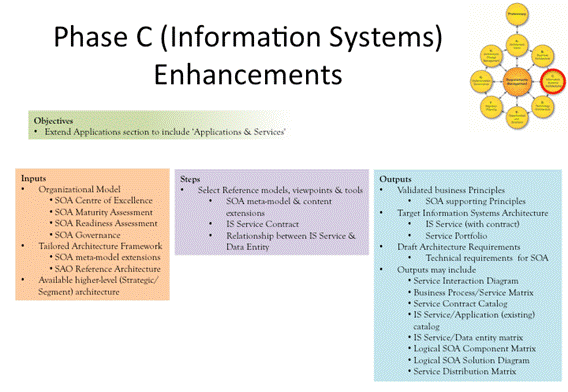
TOGAF membagi Fase C – Arsitektur Sistem Informasi – menjadi dua bagian, mencakup pengembangan data dan aplikasi arsitektur. Dokumentasi TOGAF memiliki bab pengantar singkat yang mencakup kedua domain, diikuti oleh bab terpisah untuk data dan aplikasi. Seperti fase pengembangan arsitektur lainnya (B&D), tujuannya adalah untuk mengembangkan arsitektur sistem informasi target untuk data dan aplikasi, serta mengidentifikasi komponen peta jalan arsitektur kandidat berdasarkan kesenjangan antara arsitektur dasar dan target.
Fase C selalu melibatkan kombinasi arsitektur data dan aplikasi. Tidak masalah dalam urutan mana yang disediakan selama keduanya disertakan – ada pendukung untuk kedua pendekatan. Langkah-langkah untuk data dan aplikasi sangat mirip – pilih model referensi, sudut pandang, dan alat; kembangkan baseline kemudian temukan deskripsi arsitektur, lakukan analisis kesenjangan dan definisikan komponen peta jalan kandidat; dan tangani dampak apa pun di seluruh konteks arsitektur. Setelah tinjauan pemangku kepentingan formal, arsitektur diselesaikan dan dokumen definisi arsitektur dibuat.
Perbedaan utama antara data dan aplikasi adalah subjeknya, yang tercermin dalam penggunaan model referensi, teknik, dan representasi arsitektur yang berbeda. Misalnya, arsitektur data mungkin menggunakan diagram entitas-hubungan atau diagram kelas, sementara arsitektur aplikasi mungkin menggunakan diagram komunikasi aplikasi atau diagram rekayasa perangkat lunak.
Fase D: Arsitektur Teknis:
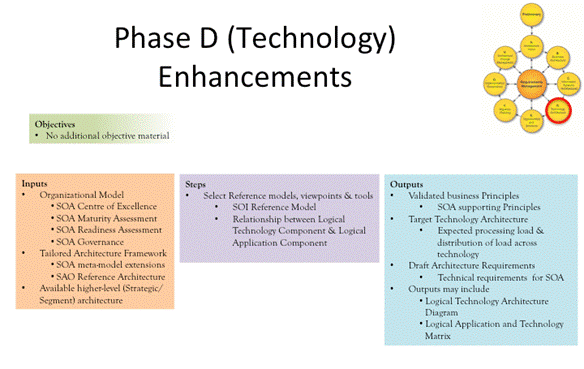
Fase D adalah fase TOGAF, yang mengembangkan arsitektur teknis untuk proyek arsitektur. Arsitektur teknologi menggambarkan struktur dan interaksi layanan platform serta komponen teknologi logis dan fisik. Fase D mengembangkan arsitektur teknologi target yang mendukung komponen data dan aplikasi (yang dikembangkan di Fase C), memungkinkan komponen bisnis.
Arsitektur yang dikembangkan dalam Fase B, C, dan D bergabung untuk mewujudkan visi arsitektur – menangani kekhawatiran pemangku kepentingan dan permintaan untuk pekerjaan konstruksi. Seperti fase pengembangan arsitektur lainnya, Fase D mengidentifikasi komponen peta jalan arsitektur kandidat untuk memungkinkan transisi dari Baseline ke Target. Langkah-langkah dalam Fase D hampir identik dengan yang ada di Fase B dan C – perbedaan utamanya adalah fokus sekarang pada teknologi. Oleh karena itu, ini mencakup model referensi teknis dan standar atau ukuran teknis – seperti kinerja, pemeliharaan, lokasi, dan latensi atau ketersediaan.
Penting untuk mengidentifikasi keluaran dan hasil untuk membantu membangun arsitektur teknis yang benar-benar mendukung sistem informasi dan arsitektur bisnis. Mendapatkan ruang lingkup yang tepat dapat mempercepat pengembalian investasi, sementara ruang lingkup yang terlalu besar akan menghambat implementasi yang sukses. Ini bukan tentang menerapkan teknologi itu sendiri, tetapi tentang mengembangkan arsitektur teknis yang benar-benar menangani visi arsitektur dan permintaan kerja.
Fase E: Peluang dan Solusi:
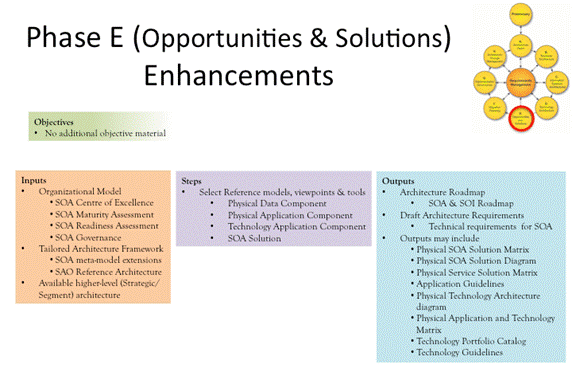
Fase E mendapatkan namanya – ia mencari peluang untuk menyampaikan arsitektur target dengan menerapkan solusi tertentu. Fase E menghasilkan versi penuh pertama dari peta jalan arsitektur dengan menggabungkan analisis dan rekomendasi dari fase pengembangan bangunan – B, C, dan D.
Fase ini berfokus pada bagaimana menyediakan skema. Oleh karena itu, fase ini melihat pada pembuatan peta jalan arsitektur, mencantumkan paket kerja dalam garis waktu untuk mencapai arsitektur target. Ketika perubahan begitu besar sehingga tidak mungkin untuk langsung beralih dari arsitektur dasar ke arsitektur target, maka Fase E menghasilkan pendekatan bertahap, yang terdiri dari arsitektur perantara atau transisi. Fase E memetakan perubahan arsitektur yang diperlukan ke program investasi dan proyek dengan pendanaan dan sumber daya untuk melaksanakan paket kerja dan menyediakan arsitektur transisi dan target. Input untuk tahap ini hampir semuanya adalah keluaran dari tahap sebelumnya. Langkah-langkah ini mengambil keluaran tersebut; mengkonsolidasikannya, menganalisis ketergantungan dan menyelesaikan perbedaan; dan menegaskan kembali bahwa organisasi mampu melakukan perubahan. Fase E menyempurnakan dan memperbarui persyaratan, dokumentasi arsitektur, dan peta jalan arsitektur. Keluaran kunci adalah langkah pertama dalam rencana implementasi dan migrasi.
Fase F: Perencanaan Migrasi:
Tahap awal ADM mengidentifikasi kebutuhan akan perubahan arsitektur dan kemudian mengembangkan arsitektur bisnis, data, aplikasi, dan teknis untuk mendukung kebutuhan ini. Fase kedua kemudian mengembangkan rencana implementasi dan migrasi untuk memanfaatkan peluang investasi dan mengidentifikasi solusi spesifik. target arsitektur. Fase F menyelesaikan rencana implementasi dan migrasi, serta peta jalan arsitektur akhir.
Ini juga memastikan bahwa rencana tersebut selaras dengan pendekatan manajemen perubahan yang digunakan dalam perusahaan dan dengan rencana lain di seluruh portofolio perubahan. Akhirnya, Fase F memastikan bahwa pemangku kepentingan kunci sepenuhnya memahami nilai bisnis, biaya paket kerja, dan arsitektur transisi dan masa depan. Sementara tahap awal ADM sangat dipandu oleh tim Arsitektur Perusahaan, tahap dari E hingga H memerlukan kolaborasi dengan agen perubahan lainnya. Fase F secara khusus memerlukan empat kerangka manajemen untuk bekerja sama dengan erat agar program implementasi dan pemindahan berhasil. Empat area tersebut adalah:
- rencana bisnis
- Arsitektur Perusahaan
- Manajemen Portofolio
- manajemen proyek
Bekerja sama, keempat area ini harus memprioritaskan pekerjaan, menggunakan kriteria seperti pengukuran kinerja, pengembalian investasi, nilai bisnis, faktor keberhasilan kritis, ukuran efektivitas, dan kesesuaian strategis.
Fase G: Menerapkan Tata Kelola:
Pengembangan dan implementasi yang sebenarnya berlangsung bersamaan dengan Fase G. Fase G memastikan bahwa proyek implementasi, serta proyek lain yang sedang berlangsung, sesuai dengan arsitektur yang ditentukan.
Biasanya, arsitektur target dikembangkan sebagai serangkaian transisi untuk mewujudkan nilai bisnis dan manfaat secepat mungkin dan mengurangi risiko dalam rencana transformasi. Setiap transformasi mewakili langkah menuju perusahaan target dan mewujudkan kepentingan bisnisnya sendiri.
Ketika kita mencapai Fase G, arsitektur telah dikembangkan (dari Fase A hingga Fase D), peluang dan solusi untuk menyampaikan arsitektur telah diidentifikasi (di Fase E), dan rencana implementasi dan migrasi yang rinci telah diselesaikan (di Fase F). Oleh karena itu, peran tim arsitektur Fase G adalah untuk memberikan pengawasan terhadap implementasi arsitektur. Ini dilakukan dengan mengonfirmasi ruang lingkup dan prioritas penerapan, membimbing pengembangan dan penerapan solusi, serta melakukan tinjauan kepatuhan. Dokumen kontrak arsitektur digunakan untuk mendorong perubahan arsitektur. Dihasilkan di awal Fase G dan disetujui oleh fungsi arsitektur dan mereka yang bertanggung jawab atas implementasi, ini adalah mekanisme untuk menilai kepatuhan tata kelola arsitektur.
Fase H: Manajemen Perubahan Arsitektur:
Tidak ada yang berjalan persis seperti yang direncanakan – akan selalu ada persyaratan baru dan kebutuhan untuk mengubah arsitektur. Fase H menggambarkan proses manajemen perubahan untuk mengelola perubahan pada arsitektur dengan cara yang kohesif dan arsitektural. Seringkali, ini memerlukan pemantauan terus-menerus terhadap permintaan tata kelola, teknologi baru, atau perubahan dalam lingkungan bisnis.
Proses ini harus mendukung arsitektur perusahaan yang diterapkan sebagai lingkungan dinamis yang dapat berkembang dengan cepat sebagai respons terhadap perubahan ini. Di Fase H, sangat penting bahwa badan pengatur menetapkan kriteria untuk menilai apakah permintaan perubahan memerlukan pembaruan arsitektur sederhana, atau apakah siklus baru dari Metode Pengembangan Arsitektur (ADM) perlu dimulai. Penting untuk menghindari “merangkak anggun”, jadi perubahan harus terkait langsung dengan nilai bisnis. Bagaimana arsitektur perusahaan digunakan adalah bagian terpenting dari siklus pengembangan arsitektur, jadi memantau pertumbuhan dan penurunan bisnis di Fase H sangat penting. Pada akhirnya, arsitektur perusahaan yang berfungsi untuk suatu organisasi kemarin tidak lagi mendukung fungsionalitas saat ini atau masa depan. Keluaran permintaan perubahan dari Fase H dapat dikategorikan sebagai penyederhanaan – biasanya didorong oleh kebutuhan untuk mengurangi investasi; perubahan bertahap – diperlukan untuk menangkap nilai tambahan dari investasi yang ada; atau perubahan desain ulang, yang didorong oleh kebutuhan untuk meningkatkan investasi dan menciptakan nilai baru.
Manajemen Persyaratan Arsitektur:
Persyaratan dihasilkan, dianalisis, dan ditinjau di setiap tahap ADM. Fase manajemen persyaratan menggambarkan proses pengelolaan persyaratan arsitektur ini sepanjang ADM. Tahap Manajemen Persyaratan adalah inti dari ADM – itulah sebabnya ia ditampilkan di tengah Lingkaran Kliping ADM. Fase ini menggambarkan proses manajemen persyaratan dan bagaimana proses itu terhubung dengan fase-fase lain dari ADM. Persyaratan tidak statis – mereka berkembang secara dinamis saat kita menyelesaikan setiap tahap ADM dan antara siklus ADM. Persyaratan arsitektur perusahaan dan perubahan selanjutnya terhadap persyaratan tersebut akan diidentifikasi, disimpan, dan input serta output terkait dengan fase ADM, dan antara siklus ADM. Menangani perubahan permintaan sangat penting. Arsitektur berurusan dengan ketidakpastian dan perubahan – ‘area abu-abu’ antara harapan pemangku kepentingan dan kemungkinan! Oleh karena itu, persyaratan arsitektur selalu tunduk pada perubahan. Selain itu, arsitektur melibatkan banyak penggerak dan batasan yang berada di luar kendali bisnis – seperti kondisi pasar yang berubah atau undang-undang baru – yang dapat menciptakan perubahan permintaan dengan cara yang tidak terduga. TOGAF menekankan bahwa proses manajemen persyaratan itu sendiri tidak menangani, menyelesaikan, atau memprioritaskan persyaratan karena ini dilakukan di fase ADM yang relevan. Fase manajemen persyaratan hanyalah proses pengelolaan persyaratan sepanjang ADM. Oleh karena itu, persyaratan arsitektur selalu tunduk pada perubahan. Selain itu, arsitektur melibatkan banyak penggerak dan batasan yang berada di luar kendali bisnis – seperti kondisi pasar yang berubah atau undang-undang baru – yang semuanya menciptakan perubahan permintaan dengan cara yang tidak terduga. TOGAF menekankan bahwa proses manajemen persyaratan itu sendiri tidak menangani, menyelesaikan, atau memprioritaskan persyaratan karena ini dilakukan di fase ADM yang relevan. Fase manajemen persyaratan hanyalah proses pengelolaan persyaratan sepanjang ADM. TOGAF menekankan bahwa proses manajemen persyaratan itu sendiri tidak menangani, menyelesaikan, atau memprioritaskan persyaratan karena ini dilakukan di fase ADM yang relevan. Fase manajemen persyaratan hanyalah proses pengelolaan persyaratan sepanjang ADM.
(*Sumber: TOGAF ADM: Apa itu, dan mengapa itu sangat penting?)
TOGAF
- Apa itu TOGAF?
- Tutorial TOGAF ADM
- Kerangka TOGAF 9.1 – Panduan Komprehensif
- Perangkat Lunak TOGAF untuk Arsitektur Perusahaan
- Perangkat Lunak TOGAF Terbaik
ArchiMate 3
- Apa itu ArchiMate?
- Panduan Sudut Pandang ArchiMate Lengkap
- Pembaruan ArchiMate 3
- Apa yang Baru di ArchiMate 3?
- Menggunakan Alat ArchiMate dengan TOGAF ADM
This post is also available in Deutsch, English, Español, فارسی, Français, 日本語, Polski, Portuguese, Ру́сский, Việt Nam, 简体中文 and 繁體中文.













